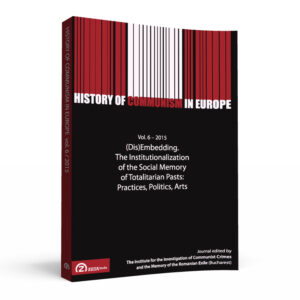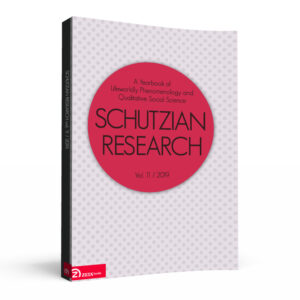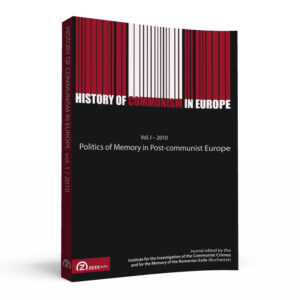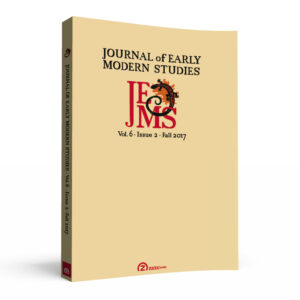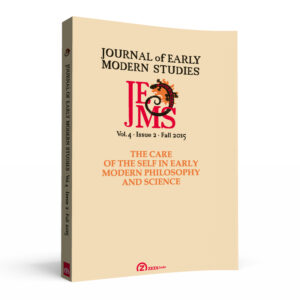FOREWORD
Radu Preda: What Must We Not Forget
ARGUMENT
Dalia BATHORY: Authoritarian and Post-authoritarian Practices of Building Collective Memory in Central and Eastern Europe
- Abstract: Among the most used expressions in scholarly articles concerning collective memory, is “dealing with the past”, or its more specific alternative, “dealing with the traumatic past”. This is a rather inexact formulation, because what scholars, artist, curators deal with is not the past in itself but the manner in which it is narrated and represented, or remembered, reconstructed. A series of questions are triggered by this statement: who “remembers”, for what purpose, with what consequences? The scope of this yearbook is to present two different ways of approaching the construction of collective remembrance: the authoritarian one and the post-authoritarian one. The articles discuss case studies of collective memory and identity building in Communist Romania, comparative studies of participative art in post-authoritarian regimes in Central and Eastern Europe, or intricate artistic approaches of traumatic collective memories
I. COMMUNISM EMBEDDED – BOOKS, SHELVES, CURTAINS
Ruxandra CÂMPEANU: “Revis(it)ing the Romanian Cultural Heritage” during Gheorghe Gheorghiu-Dej’s Regime: The Role of Literary Critics in the Battle for the Canon as a Form of Preserving the Cultural Memory of a Community
- Abstract: As an instrument of preserving the cultural memory of a community, the literary canon is usually a highly stable structure in its core elements. However, with the advent of the Communist regime after the Second World War, the Romanian literary canon underwent a drastic process of reconstruction. As early as the 1940s, what was euphemistically dubbed “revisiting our cultural heritage” actually equated to a radical revision—a purge of the literary canon through the filter of Marxism-Leninism. Not only writers of literature, but literary critics themselves were subjected to this process. In this paper, I aim to discuss the role played by literary critics active during Gheorghe Gheorghiu-Dej’s regime in rehabilitating their predecessors. My focus will be on the press debate surrounding Titu Maiorescu’s rehabilitation in 1963.
Claudia ȘERBĂNUȚĂ: Memory Exercises in Public Libraries
- Abstract: The main roles of libraries are developing and providing access to collections of cultural heritage. While the specific policies necessary to accomplish these roles may vary across different types of libraries, these institutions have at their core a dual role in preserving and supporting access to documents illustrating an era of knowledge and culture. Libraries are thus significant institutions in the process of learning, but also in that of remembering and forgetting at a social level. This article provides an overview of the structure and organization of the public library system in the last two decades of the Communist regime in Romania. As part of a larger information history project, the research discusses the characteristics of this system created to support mass education and the ways in which public libraries also became institutions of memory in Communist Romania. The description of the library system structure is enriched by an overview of the professional training available for librarians and descriptions of the main library services related to access to collections and memories. The analysis of archival materials and oral history interviews with librarians document how these services were implemented and delve into the challenges encountered. Partial access to knowledge and information was a core part of the offered library services. As a consequence, services that were part of the Communist library system could be a source of long-term memory impairment at the social level.
Bianca FELSEGHI: Profiling The Audience: Theatre and Repertoires In 1970’s Romania. Case Study: The National Theatre in Cluj-Napoca
- Abstract: During the late 60s and the beginning of the 1970s, the changes within the Communist Party which followed the death of Gheorghe Gheorghiu-Dej, the former Secretary General, led to a certain openness for culture and arts, from an ideological point of view. The so-called ideological “thaw” would not last more than 6 years, but it was needed all along in order for the new nomenklatura system of Ceauşescu’s generation to take over the rule of the state and of the party. This is the broader context in which the relationship between the theatre repertories, the audience and the politics would develop further in a very insidious way. Facing a massive “peasantization of the working class” due to the regime’s investments in the industrial sector, the configuration of the urban population in Romanian cities had changed significantly. Th e inflow of poorly educated persons had a strong negative impact on the efforts to educate the urban population in the working-class socialist ethics. In this study we are profiling the beneficiaries of the cultural policies of the regime: What were their cultural background and their expectations regarding theatre and why did the authorities intervene in regulating the theatre market?
II. THE PAST BEHIND THE SHOWCASE
Irina HASNAS-HUBBARD: Memorialization of Challenging Topics. Artists’ Interventions as Examples of Museum (Good) Practice
- Abstract: Challenging topics in museums can guide museum professionals in developing modern methods of displaying their heritage, but also in offering reinterpretations of existing collections. Th e public also looks for challenging topics—injustice, loss, pain, or death—and many museums manage to attract visitors by offering them places to debate, reflect, or take action. These topics, if presented in an exhibition, could engage practising artists in an ideological exchange with the museum institution. Our statement is that artists with curatorial interest can scrutinise the ways in which cultural heritage is revealed or interpreted for the contemporary public. The uncomfortable or uncertain aspects of recent and contemporary history are of great interest for contemporary artists and we assume that the Communist era in Romania could be further interpreted by artists in future museum places.
Ewa JANISZ: Atrocity and Aesthetics.The Politics of Remembering and Representing the Holocaust in Polish Contemporary Art: Zbigniew Libera’s “Lego Concentration Camp”
- Abstract: This paper discusses the politics of remembering and the representation of the Holocaust in Polish contemporary art referring to the Lego Concentration Camp (1996) by Zbigniew Libera. The paper presents the ways in which Libera’s work challenges the traditional ways of representing the Holocaust and how it engages with issues such as the relation between atrocity and aesthetics. The associations brought to this mode of representation by the notions of game and toys and whether theatricality and play are in dialogue with or violate the historical experience of the Holocaust is also discussed. The paper investigates the specificity of the Polish context in the way the Holocaust is approached and the reactions these artistic attempts raise in the public. Do the unconventional and shocking representations help understand the Holocaust or do they create the opposite effect of misguided and trivialised reading of history?
Andrea BRAIT: The Nation as a Victim: Perspectives in Hungarian Museums
- Abstract: Based on retrospection on the reappraisal of the past in Hungary since 1989, this text analyses the representation of the Communist era in the Magyar Nemzeti Múzeum, the Terror Háza Múzeum and the Hadtörténeti Múzeum Budapest. All three museums place the suppression of the Hungarian people at the centre of their narration, while depicting the Hungarian nation as a victim. Th e 1956 revolution is staged as a central turning point in the second half of the 20th century, which supplies the narrative with a fresh set of martyrs. In this context, Imre Nagy not only takes the role of an icon with regard to the events of 1956, but his re-interment is also seen as a climax of the turnabout of 1989.
Ioana HAȘU: Recalling Trauma: Photographs as Links to a Memory Chain for Survivors of Armed Anti-Communist Resistance in Romania
- Abstract: Using the concept of postmemory—coined by Mariane Hirsch—this paper explores the role of photographs in recalling past trauma in two families who participated in the anticommunist armed resistance in Romania. Members of these families were executed and the survivors had to endure further persecution. Th e interviews revealed that some pictures off er the frame for remembering suppressed memories. The images have peculiar meanings for different generations of the same family. For the participants in this study, seeing the photographs equates to reliving a past trauma and giving a new meaning to it. Pictures function as realms of encounter and reconciliation between present and past generations of same the family. The first outcome of the process is memory recovery; in this, people also recover their identity and the result is transgenerational healing. Some of the interviews discussed in this paper were done with members of my family.
III. IMMANENT HISTORIES, TANGIBLE MEMORIES
Melinda HARLOV: A Square that Has Seen it All: The History of the Nowadays ’56-ers Square in Budapest
- Abstract: This research discusses the history of a certain space in the capital of Hungary as the physical concretization of the Soviet Union’s ideological impact on the country. Even though this 360 meters × 85 meters territory has had a very short lifetime of circa sixty years, it has been the location of many political and cultural events of nationwide importance. After the territorial and chronological contextualization, this article introduces the story of all the planned, established, demolished or removed public buildings and statues that were located there from the mid-20th century until 2011. The text contains art analysis and comparative research methodologies to point out the conscious allusions and unconscious correlations of different regimes and their aims and ideologies in time. The third section provides possible explanations and analyzing tools to understand the relevance (political representational role) and the possible future options (including the evaluation of the recent past) of the square. Lastly, the paper points out further possible research directions to investigate the broader topic of the connection between an urban location and the representational will of the contemporary leadership from different angels.
Maria-Alina ASAVEI: Participatory Cultures of Remembrance: The Artistic Memory of the Communist Past in Romania and Bulgaria
- Abstract: This paper examines the participatory trend in cultural memory practices, focusing on the participatory artistic memory of communism in Romania and Bulgaria from a comparative perspective. On the one hand, these participatory artistic memory projects examine the ways in which ordinary people and contemporary artists share their memories of the communist past outside of the officially sanctioned interpretations, aiming to foster their own version of “monument” that does not necessarily follow the ossifying politics of monuments. On the other hand, a participatory memory culture does not always necessarily reflect the unequal cultural capital of the participating social actors and the dissimilar political commitments. This mnemonic practice ought not to be exclusively associated with the struggle between the narratives of the elites and the cultural expressions of those marginalized. Participatory memory practices might also facilitate cordial encounters among persons with dissimilar political commitments and unequal cultural capital.
IV. BOOK REVIEW
Ștefan BOSOMITU: Cristina DIAC, Zorii comunismului în România. Ştefan Foriş, un destin neterminat [The Dawns of Communism in Romania. Ştefan Foriş, an Unaccomplished Destiny], Cetatea de Scaun, 2014
ISSN: 2069-3192 (paperback)
ISSN: 2069-3206 (electronic)
ISBN: 978-606-697-030-3 (E-book)
ISBN: 978-606-697-031-0 (Paperback)


